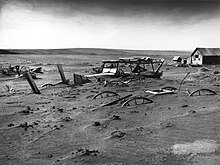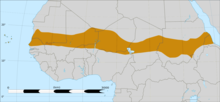- begin partial quote from both word buttons
- 3 Consequences
- 4 Globally
Consequences
A Mongolian gazelle dead due to drought.
Drought can also reduce water quality,[40][41] because lower water flows reduce dilution of pollutants and increase contamination of remaining water sources. Common consequences of drought include:
- Diminished crop growth or yield productions and carrying capacity for livestock
- Dust bowls, themselves a sign of erosion, which further erode the landscape
- Dust storms, when drought hits an area suffering from desertification and erosion
- Famine due to lack of water for irrigation
- Habitat damage, affecting both terrestrial and aquatic wildlife[42]
- Hunger, drought provides too little water to support food crops.
- Malnutrition, dehydration and related diseases
- Mass migration, resulting in internal displacement and international refugees
- Reduced electricity production due to reduced water flow through hydroelectric dams[43]
- Shortages of water for industrial users[44][45]
- Snake migration, which results in snakebites[46]
- Social unrest
- War over natural resources, including water and food
- Wildfires, such as Australian bushfires, are more common during times of drought and even death of people.[47]
- Exposure and oxidation of acid sulfate soils due to falling surface and groundwater levels.[48][49][50]
Globally
Drought is a normal, recurring feature of the climate in most parts of the world. It is among the earliest documented climatic events, present in the Epic of Gilgamesh and tied to the biblical story of Joseph's arrival in and the later Exodus from Ancient Egypt.[51] Hunter-gatherer migrations in 9,500 BC Chile have been linked to the phenomenon,[52] as has the exodus of early humans out of Africa and into the rest of the world around 135,000 years ago.[53]
A South Dakota farm during the Dust Bowl, 1936
Examples
Main article: List of droughts
Well-known historical droughts include:- 1900 India killing between 250,000 and 3.25 million.
- 1921–22 Soviet Union in which over 5 million perished from starvation due to drought
- 1928–30 Northwest China resulting in over 3 million deaths by famine.
- 1936 and 1941 Sichuan Province China resulting in 5 million and 2.5 million deaths respectively.
- The 1997–2009 Millennium Drought in Australia led to a water supply crisis across much of the country. As a result, many desalination plants were built for the first time (see list).
- In 2006, Sichuan Province China experienced its worst drought in modern times with nearly 8 million people and over 7 million cattle facing water shortages.
- 12-year drought that was devastating southwest Western Australia, southeast South Australia, Victoria and northern Tasmania was "very severe and without historical precedent".
Affected areas in the western Sahel belt during the 2012 drought.
Approximately 2.4 billion people live in the drainage basin of the Himalayan rivers.[55] India, China, Pakistan, Bangladesh, Nepal and Myanmar could experience floods followed by droughts in coming decades. Drought in India affecting the Ganges is of particular concern, as it provides drinking water and agricultural irrigation for more than 500 million people.[56][57][58] The west coast of North America, which gets much of its water from glaciers in mountain ranges such as the Rocky Mountains and Sierra Nevada, also would be affected.[59][60]
In 2005, parts of the Amazon basin experienced the worst drought in 100 years.[61][62] A 23 July 2006 article reported Woods Hole Research Center results showing that the forest in its present form could survive only three years of drought.[63][64] Scientists at the Brazilian National Institute of Amazonian Research argue in the article that this drought response, coupled with the effects of deforestation on regional climate, are pushing the rainforest towards a "tipping point" where it would irreversibly start to die. It concludes that the rainforest is on the brink of being turned into savanna or desert, with catastrophic consequences for the world's climate. According to the WWF, the combination of climate change and deforestation increases the drying effect of dead trees that fuels forest fires.[65]
By far the largest part of Australia is desert or semi-arid lands commonly known as the outback. A 2005 study by Australian and American researchers investigated the desertification of the interior, and suggested that one explanation was related to human settlers who arrived about 50,000 years ago. Regular burning by these settlers could have prevented monsoons from reaching interior Australia.[68] In June 2008 it became known that an expert panel had warned of long term, maybe irreversible, severe ecological damage for the whole Murray-Darling basin if it did not receive sufficient water by October 2008.[69] Australia could experience more severe droughts and they could become more frequent in the future, a government-commissioned report said on July 6, 2008.[70] Australian environmentalist Tim Flannery, predicted that unless it made drastic changes, Perth in Western Australia could become the world’s first ghost metropolis, an abandoned city with no more water to sustain its population.[71] The long Australian Millennial drought broke in 2010.
Recurring droughts leading to desertification in East Africa have created grave ecological catastrophes, prompting food shortages in 1984–85, 2006 and 2011.[72] During the 2011 drought, an estimated 50,000 to 150,000 people were reported to have died,[73] though these figures and the extent of the crisis are disputed.[74] In February 2012, the UN announced that the crisis was over due to a scaling up of relief efforts and a bumper harvest.[75] Aid agencies subsequently shifted their emphasis to recovery efforts, including digging irrigation canals and distributing plant seeds.[75]
In 2012, a severe drought struck the western Sahel. The Methodist Relief & Development Fund (MRDF) reported that more than 10 million people in the region were at risk of famine due to a month-long heat wave that was hovering over Niger, Mali, Mauritania and Burkina Faso. A fund of about £20,000 was distributed to the drought-hit countries.[76]
Protection, mitigation and relief
Succulent plants are well-adapted to survive long periods of drought.
Water distribution on Marshall Islands during El Niño.
Aerosols over the Amazon each September for four burning seasons (2005 through 2008) during the Amazon basin drought. The aerosol scale (yellow to dark reddish-brown) indicates the relative amount of particles that absorb sunlight.
- Dams - many dams and their associated reservoirs supply additional water in times of drought.[78]
- Cloud seeding - a form of intentional weather modification to induce rainfall.[79] This remains a hotly debated topic, as the United States National Research Council released a report in 2004 stating that to date, there is still no convincing scientific proof of the efficacy of intentional weather modification.[80]
- Desalination - of sea water for irrigation or consumption.[81]
- Drought monitoring - Continuous observation of rainfall levels and comparisons with current usage levels can help prevent man-made drought. For instance, analysis of water usage in Yemen has revealed that their water table (underground water level) is put at grave risk by over-use to fertilize their Khat crop.[82] Careful monitoring of moisture levels can also help predict increased risk for wildfires, using such metrics as the Keetch-Byram Drought Index[47] or Palmer Drought Index.
- Land use - Carefully planned crop rotation can help to minimize erosion and allow farmers to plant less water-dependent crops in drier years.
- Outdoor water-use restriction - Regulating the use of sprinklers, hoses or buckets on outdoor plants, filling pools, and other water-intensive home maintenance tasks. Xeriscaping yards can significantly reduce unnecessary water use by residents of towns and cities.
- Rainwater harvesting - Collection and storage of rainwater from roofs or other suitable catchments.
- Recycled water - Former wastewater (sewage) that has been treated and purified for reuse.
- Transvasement - Building canals or redirecting rivers as massive attempts at irrigation in drought-prone areas.









No comments:
Post a Comment